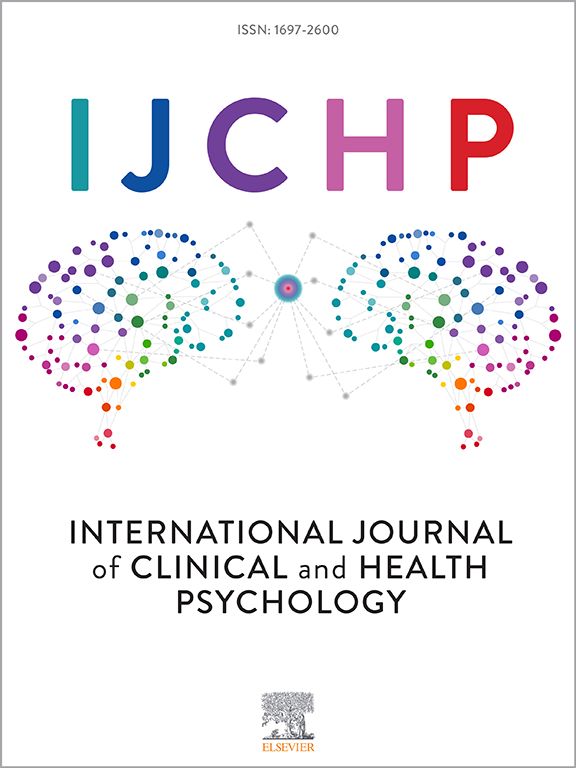DSM-5 genito-pelvic pain/penetration disorder: Prevalence, comorbidities, and associated factors in university students
IF 4.4
1区 心理学
Q1 PSYCHOLOGY, CLINICAL
International Journal of Clinical and Health Psychology
Pub Date : 2025-01-01
DOI:10.1016/j.ijchp.2024.100529
引用次数: 0
Abstract
Background/objective
Little is known about the prevalence of Genito-Pelvic Pain/Penetration Disorder (GPPPD), a female sexual dysfunction newly introduced in the DSM-5. This study aimed to estimate the 12-month prevalence of clinical and subclinical GPPPD among first-year university students in Germany, examining comorbidities and associated factors.
Method
As part of the WHO World Mental Health International College Student initiative, the 12-month prevalence of GPPPD was assessed in female university students in Germany during 2016/2017 (N = 521). Using propensity score weighting, 12-month prevalence rates were determined for clinical and subclinical GPPPD together with associated factors and mental health comorbidities using binary logistic regression.
Results
In the weighted female university student sample, 26.4 % reported experiencing at least one core symptom of GPPPD in the past 12 months. 12-month prevalence of clinical GPPPD was 2.1 % (n = 11/521; 95 % CI: 1.1 %-3.8 %), while subclinical GPPPD was 12.9 % (n = 67/521; 95 % CI: 10 %-16 %). Among women with clinical GPPPD, 25.8 % (n = 3/11) reported a comorbid lifetime mental disorder, compared to 64.6 % (n = 43/67) with subclinical GPPPD and 54.7 % (n = 243/444) without GPPPD. There were no significant differences in the odds of comorbid mental disorders between women with and without GPPPD symptoms. Subclinical and clinical GPPPD, compared to no GPPPD, were associated with being in a relationship (OR = 2.45, 95 % CI: 1.25–4.82, p = 0.009), sexual activity in the past 12 months (OR = 5.05, 95 % CI: 1.52–16.8, p = 0.008), severe distress in love life (OR=3.20, 95 % CI 1.44–7.11), and overall good compared to very good or very poor mental health (OR = 4.50, 95 % CI: 1.07–19.00, p = 0.041).
Conclusion
One in eight female students displays subclinical GPPPD, and 2 % meet full DSM-5 criteria. Future multinational longitudinal studies with standardized measures are needed to compare prevalence rates across countries and identify risk and protective factors for targeted prevention and treatment of GPPPD.
DSM-5生殖盆腔疼痛/穿透障碍:大学生患病率、合并症和相关因素
背景/目的生殖盆腔疼痛/穿透障碍(GPPPD)是DSM-5中新引入的一种女性性功能障碍,目前对其患病率知之甚少。本研究旨在评估德国一年级大学生中临床和亚临床GPPPD的12个月患病率,检查合并症和相关因素。方法作为世卫组织世界心理卫生国际大学生倡议的一部分,对2016/2017年德国女大学生中GPPPD的12个月患病率进行评估(N = 521)。采用倾向评分加权法,采用二元逻辑回归确定临床和亚临床GPPPD的12个月患病率以及相关因素和精神健康合并症。结果在加权的女大学生样本中,26.4%的人报告在过去12个月内至少经历过一种GPPPD的核心症状。临床GPPPD 12个月患病率为2.1% (n = 11/521;95% CI: 1.1% - 3.8%),而亚临床GPPPD为12.9% (n = 67/521;95% ci: 10% - 16%)。在临床GPPPD的女性中,25.8% (n = 3/11)报告了共病终身精神障碍,而亚临床GPPPD为64.6% (n = 43/67),无GPPPD为54.7% (n = 243/444)。在有和没有GPPPD症状的女性之间,共病精神障碍的几率没有显著差异。与无GPPPD相比,亚临床和临床GPPPD与处于恋爱关系(OR= 2.45, 95% CI: 1.25-4.82, p = 0.009)、过去12个月内的性活动(OR= 5.05, 95% CI: 1.52-16.8, p = 0.008)、爱情生活中的严重痛苦(OR=3.20, 95% CI: 1.44-7.11)、总体良好与非常好或非常差的心理健康(OR= 4.50, 95% CI: 1.07-19.00, p = 0.041)相关。结论1 / 8的女学生表现为亚临床GPPPD, 2%符合DSM-5标准。未来需要采用标准化措施的跨国纵向研究来比较各国的患病率,并确定有针对性地预防和治疗GPPPD的风险和保护因素。
本文章由计算机程序翻译,如有差异,请以英文原文为准。
求助全文
约1分钟内获得全文
求助全文
来源期刊

International Journal of Clinical and Health Psychology
PSYCHOLOGY, CLINICAL-
CiteScore
10.70
自引率
5.70%
发文量
38
审稿时长
33 days
期刊介绍:
The International Journal of Clinical and Health Psychology is dedicated to publishing manuscripts with a strong emphasis on both basic and applied research, encompassing experimental, clinical, and theoretical contributions that advance the fields of Clinical and Health Psychology. With a focus on four core domains—clinical psychology and psychotherapy, psychopathology, health psychology, and clinical neurosciences—the IJCHP seeks to provide a comprehensive platform for scholarly discourse and innovation. The journal accepts Original Articles (empirical studies) and Review Articles. Manuscripts submitted to IJCHP should be original and not previously published or under consideration elsewhere. All signing authors must unanimously agree on the submitted version of the manuscript. By submitting their work, authors agree to transfer their copyrights to the Journal for the duration of the editorial process.
 求助内容:
求助内容: 应助结果提醒方式:
应助结果提醒方式:


